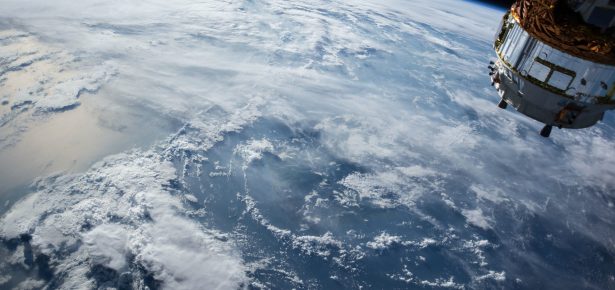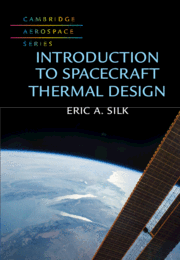
What inspired this book?
In accepting the role of instructor for the UMD (University of Maryland) course entitled “Spacecraft Thermal Design”, which the book is based upon, I quickly learned that this topic included an unanticipated challenge. In researching reference texts for the course, it quickly became apparent that there was no textbook available that walked the student through the process of thermal design and analysis of spacebased systems from fundamental heat transfer, thermodynamics and fluid dynamics principles. The standard heat transfer texts did not provide content addressing thermal design considerations and constructs for analysis of spacebased systems. Contemporary engineering texts dedicated to spacebased topics only provided a cursory overview of conduction and radiation phenomena in the space environment or addressed the topic in the context of an overall systems perspective where thermal just happened to be one of several chapters. Ultimately, the solution for providing course participants lecture content was to combine relevant information covered in previously published texts with that which I deemed important on the subject. Using this combined approach lead to the creation of detailed class notes which ultimately served as the primary text for students taking the course. Those class notes are the basis for this book. Arguably, this type of text has been a key void in space systems literature for some time. Nonetheless, now that this text has been written and released to the public, professors looking to teach this course at other universities will have an instruction manual (and textbook) available for use without the additional task that I endured of collecting information from numerous resources to piece together lecture content.
What do you hope will be the lasting impact of this book?
The focus of the book is fundamentals of spacecraft thermal design. In light of that fact, I would hope that the book serves as a basis by which aspiring enthusiasts and future practitioners of the spacecraft thermal community can gain sound fundamentals which can be further built upon throughout their engineering careers. For people newly exposed to spacebased topics, I hope it makes the design and analysis of spacebased systems a little less mysterious. I hope that the release of this text enables potential instructors of this topic with an instruction manual for their courses. Last but not least, I hope the impact of the text is such that twenty to thirty years from now it will be considered a standard read and has populated both university libraries and the bookshelves of all space practitioners.
Can you share any interesting anecdotes from the book?
Content within the book is based on the course I teach at UMD under a similar title. It is not uncommon for students to take the course to learn about, and/or explore their affinity for spacecraft thermal design. A little after the mid-semester mark, once we are immersed in the space environment energy analysis section, I tend to see a transformation in the students. They often transition from simply performing spacecraft thermal design calculations to practitioners that are asking questions which delve into the finer points of analysis techniques and constructs used. This clearly reinforces the effectiveness of the teaching material in cultivating the mind of the students/readers.
One day while exiting a building at a government agency in the Washington, DC area, I happened across a former student of the course. I stopped to chat with the junior engineer for a little while to see how things were going for them career and otherwise. During the course of the conversation, I told them that I hope the materials covered in the course (and this text) helped them along in their career. They proceeded to tell me that it helped them immensely. During the interview for the job they presently had, the interviewer began delving into spacecraft thermal topics, all of which they had seen previously through the course content. They were able to carry on a meaningful conversation in the topic and impress the interviewer with their knowledge and abilities regarding spacecraft thermal design and analysis. They were then offered the job and the rest is history. The same content that particular former student was exposed to is contained within this text. The story regarding their path to employment following graduation further reinforces the effectiveness of the materials contained within the text.
Why is your book important?
The book is important on two fronts. The first is that it fills a void in the space systems literature. For a long period of time, knowledge of design methodologies applied to spacecraft subsystems, such as thermal, have predominantly been retained within the ranks of practitioners internal to the space community. Were one desirous of learning the basics of spacecraft thermal design, the path to such was through experiential learning on the job. This book provides students (i.e., future practitioners) insights into the design and analysis process that makes them much more capable of performing thermal design and analysis tasks when they enter the aerospace workforce. The second is that there has been a renewed interest in space at the national level, as well as a commitment to getting human presence out of low Earth orbit and onto celestial bodies beyond the Moon. It has been proposed that travel to locations such as the Moon and Mars will not only be of a visiting nature, but will also include a sustained human presence. To have a sustained human presence on a celestial body requires a workforce infrastructure that includes the private sector to a greater extent than it does today. Tomorrow’s aerospace engineering workforce is trained and supplied by today’s university engineering programs. Thus, texts that promote knowledge and comprehension of space based topics at the university level help train the next generation of aerospace engineers and ultimately help to make the aforementioned plans of extending human presence further into space a reality.
Who is the primary audience for the book?
The primary audience the text is written for includes space enthusiasts, aerospace and mechanical engineering students, early career spacecraft thermal practitioners involved in design/build/test/fly activities and space systems engineers in general.
Based on your previous answer to the primary audience of the book, what are the market needs/key challenges this audience faces?
Regardless of whether one is a space enthusiast, an engineering student with an emphasis on space systems or a space practitioner, they may be considered members of the space community. Specific to the spacecraft thermal community, knowledge of how spacecraft thermal design is performed, as well as how and why heat transfer occurs in the manner in which it does in the space environment, has traditionally been knowledge passed down to practitioners in the form of on the job training. Thus, after having attained one’s engineering degree, once hired into a position involving spacecraft thermal activities, the individual had additional learning to undertake in order to become functional in this technical area. The ability to train future space practitioners in spacecraft thermal systems at the university level provides an enhanced candidate pool that lessens the early phase learning burden upon said individuals once hired into a role performing spacecraft thermal activities. However, to date there are very few universities that offer this topic. The reason for such being that knowledge on the topic has not migrated to the university sector in an instructional manner built upon other fundamental topics taught in university settings (e.g., Thermodynamics, Fluids, Heat Transfer). Access to such an instructional text at the university level has been a longstanding hurdle in the efficient development of a spacecraft thermal candidate pool for industry. In addition, software tools used to perform spacecraft thermal analysis in the professional environmental usually are not stocked in university level engineering software libraries. Thus, an additional hurdle regarding the ability to perform instruction in spacecraft thermal analysis in a university environment includes using standard software packages that are actually available within most university engineering departments.
Does your book solve this need/challenge? How?
This text is designed to walk the reader through, as well as develop a fundamental understanding of, heat transfer analysis techniques as applied to Earth based spacecraft. It is written in a methodical manner that introduces the reader to fundamental concepts and assumptions associated analysis techniques and devices commonly used in the spacecraft thermal community. Beyond the presentation of how to perform fundamental calculations, it also provides the reader with examples of how to perform analyses using standard software tools available through most university engineering programs.
What unique features do you think make the book stand out?
The primary focus of the book is upon heat transfer in the space environment, the design of temperature control systems for space application and features of some spacebased technologies frequently used in contemporary thermal control system architectures. However, the topic of spacecraft thermal design really does encompass more than just heat transfer. It also includes a healthy reliance upon thermodynamics, fluids and electrical (e.g., photovoltaics, sensors, etc.) systems. This text not only covers the heat transfer, but also elucidates the juxtaposition of these other engineering topics with heat transfer phenomena when it comes to the design, analysis, build and flight of thermal control systems. Rarely, if at all, have I seen a heat transfer text in this style and format. From that perspective, it is very unique and stands out relative to other texts on the market. The text covers practical design issues such as “limiting resistance”, within a thermal circuit. Topics like these are not widely discussed in alternate heat transfer texts. It also includes example code for the calculation of solutions using software tools immediately available to the university community. Each of these features make the book stand out.

Find out more about Introduction to Spacecraft Thermal Design
Latest Comments
Have your say!